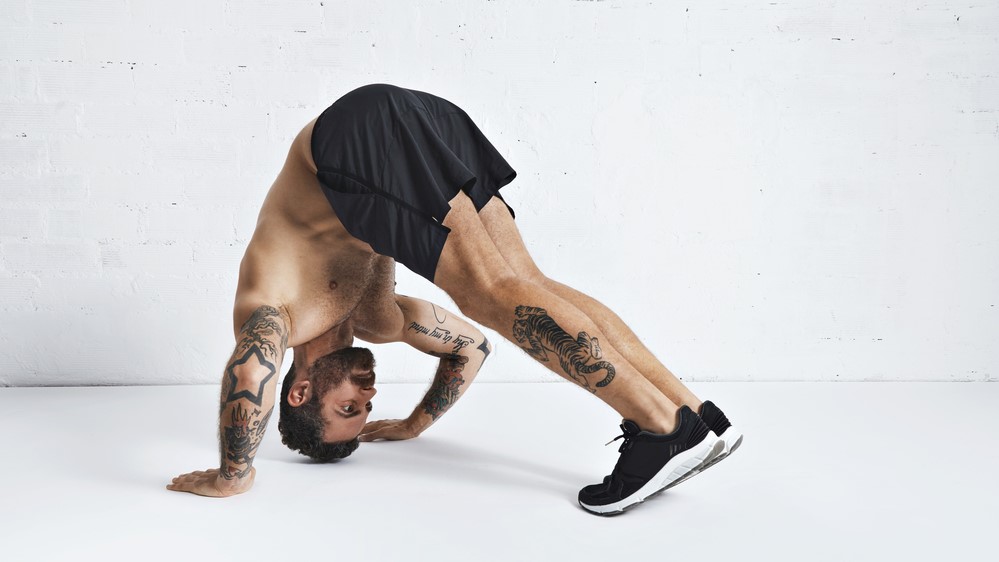Samsung Galaxy S5 vs HTC One M8: Face-Off!
After comparing the Samsung Galaxy S5 and HTC One M8, we’re ready to crown one of these flagship phones champion. And the winner is…
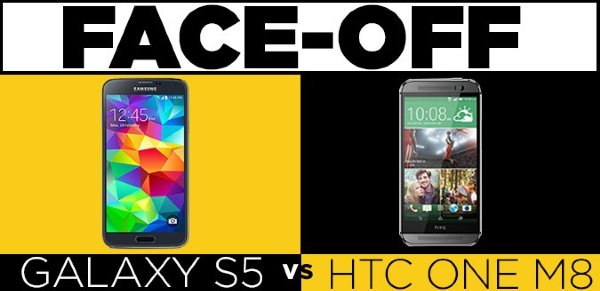
Welcome to the ultimate Android phone showdown of 2014. The Samsung Galaxy S5 and HTC One M8 both bring high-powered specs, big and beautiful screens and new innovations to the table. But they also have very different personalities.
The Galaxy S5 stands out because of its water-resistant design, integrated heart rate monitor and fingerprint scanner, as well as its real-time HDR camera. The One M8 sports a sleek metal design, a new Duo Camera that lets you get creative with photos and gesture-controlled launch shortcuts.
So which flagship phone is the champ? Our grueling 10-round prizefight will answer that question.
Editors' Note: Additional reporting and testing by Daniel Howley.
Design
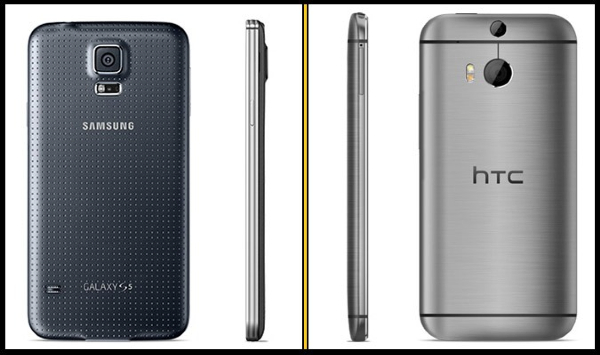
Just look at these two phones. The HTC One M8 sports a sexy aluminum body that's 90 percent metal, and the Galaxy S5 is plastic. The One has a curved backside and the S5 is flat with dots. The HTC sports polished edges, while the S5's edges are all faux metal. This round just isn't fair.
But wait. Only the Galaxy S5 has a water-resistant body, which means it can withstand a splash or even a dunking. We also prefer the power button placement on the S5--on the right edge right near your thumb. The One M8's button is on top, which is more of a stretch.
We also prefer the S5's physical home button to the software-based buttons on the One M8. For example, if you're using the One M8's Camera app and want to go to the home screen you have to press the screen once to make the Home button appear, then tap it.
Get instant access to breaking news, the hottest reviews, great deals and helpful tips.
On the other hand, the Galaxy S5 has a pretty annoying charging cover flap (used to keep water out) that you must remove each time you plug in a micro USB cable.
The One M8 is definitely chunkier and heftier, measuring 5.8 x 2.8 x 0.37 inches and weighing 5.6 ounces, while the S5 is 5.6 x 2.9 x 0.32 inches and 5.1 ounces.
Winner: HTC One M8. This round was closer than we initially thought. We really like the Galaxy S5's water resistance and physical home button, but the metal design of the One M8 is more attractive and elegant.
Display
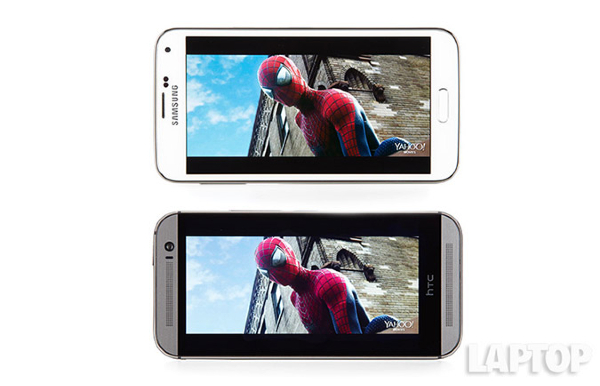
The HTC One M8's 5-inch LCD and the Galaxy S5's 5.1-inch Super AMOLED screen are two of the best yet, but one reigns supreme.
First, we looked at the same movie trailer, "The Amazing Spider-Man 2." The S5's display delivered a much more vibrant red in Spider-Man's suit, which looked magenta on the One M8's screen. And while the sky looked blown out and almost gray on the One, it looked blue on the S5.
The S5 trumps the One M8 in brightness, too, registering 493 lux on our light meter (373 nits on our colorimeter), compared with 460 lux and 368 nits for the HTC.
The Galaxy S5's OLED panel outshines the One M8 in other ways. The former phone turned in a Delta-E score of 0.9 (lower numbers are better) on our color accuracy test, while the One M8 hit 4.1. Last but not least, the S5 produces more of the sRGB color gamut than the One M8, 158 versus 115 percent.
Winner: Galaxy S5. On its own the HTC One M8 has an excellent screen, but the S5's is practically perfect.
Audio
The One M8's dual BoomSound speakers are in a class of their own. They're not only 20 percent louder than last year's model, they deliver much richer and deeper sound.
We noticed a clear difference between the One M8 and the S5 when we played Pharell William's "Happy." The track sounded fuller on the HTC, while the vocals drowned out the instruments on the S5's tinny single speaker on the back.
On the Laptop Mag Audio test, which measures a device's audio output at a distance of 13 inches using a continuous tone, the One M8 registered 83 decibels. The S5 mustered only 73 dB.
Winner: HTC One M8. The One M8's speakers are so good you may not want--or need--a Bluetooth speaker to rock out.
Interface
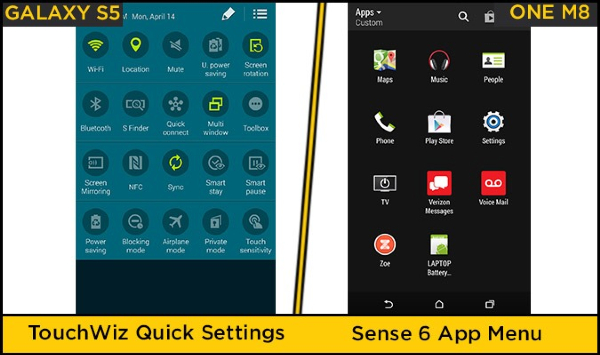
Samsung has made its TouchWiz interface a little less cluttered by applying a flat iOS7-style makeover to some elements. For example, the options in the quick settings menu are now represented by circles. The regular settings menu gets the same treatment, but it's a more colorful presentation.
Nevertheless, the HTC One M8's Sense 6 software has an even cleaner overall aesthetic. The app menu is a good example, which puts plenty of space between the icons and presents shortcut buttons for Search, Google Play and Settings along the top for easy access.
The Galaxy S5 wins the quick settings portion of this contest, because it requires fewer steps to access. For instance, on the Samsung you just swipe down from the top of the screen and you can start operating a slider to control the brightness. On the One M8, you need to swipe down, then press a settings button and then hit a brightness button (there's no slider).
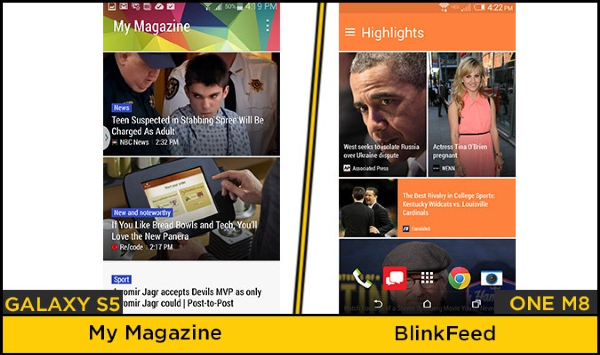
Both the Galaxy S5 and One M8 provide a news/social reader tool to the left of the main home screen. Samsung's My Magazine is powered by Flipboard, while HTC's BlinkFeed is homegrown. We prefer the latter option. First, only BlinkFeed offers Facebook integration. We also find it easier to customize the feed on the One M8; the S5 requires more digging. Plus, HTC is working with app developers such as Fitbit to make BlinkFeed even more powerful.
The S5 and One M8 present different ways of switching apps. The S5 shows four large thumbnails at once, while the One M8 shows nine in a grid. The S5's presentation looks prettier but the M8 gets the nod here because it lets you see more at once.
Winner: HTC One M8. Although we strongly prefer the S5's quick settings menu, the One M8's interface is more attractive and intuitive.
Keyboard

The Galaxy S5's keyboard carries over the majority of the features found on the S4, which is a good thing. We especially like the handset's dedicated number row, which is great for passwords. We were also pleased with the SwiftKey Swype capability and predictive text functionality.
Despite the One's larger keyboard keys, we found typing on the S5 to be far more accurate. This is likely a result of the large gaps between keys on the S5 versus the compact keys on the One. On the Typing Master app test, we averaged 16 words per minute with an accuracy rate of 84 percent while using the S5. While using the One M8 we reached just 12 words per minute with a 70 percent accuracy rate.
Winner: Samsung Galaxy S5. We typed faster and more accurately on the S5, and it has a dedicated number row.
Performance
We'll get to the synthetic benchmarks, but we're more interested in how the Galaxy S5's 2.5-GHz Snapdragon 801 processor stacks up against the One M8's 2.3-GHz Snapdragon 801 chip in real-world use.
First, we opened and exited the browser several times to see how fast each device returned to the home screen. The One M8 finished faster every single time, with an advantage of a half second to a second. There's just more lag with the Galaxy S5.
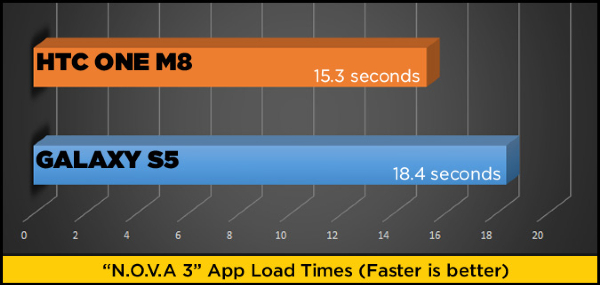
We then loaded the resource-intensive "N.O.V.A. 3" game on both phones three times and averaged the results. (Each time we tested the phone to make sure the game wasn't still in the memory.) The One M8 finished in 15.3 seconds, compared with 18.4 seconds for the S5.
We also timed how long it took each smartphone to fire up the camera straight from the lock screen. This time the devices were fairly close, but the One M8 still averaged a slightly faster 1.5 seconds versus the S5's 1.56 seconds.
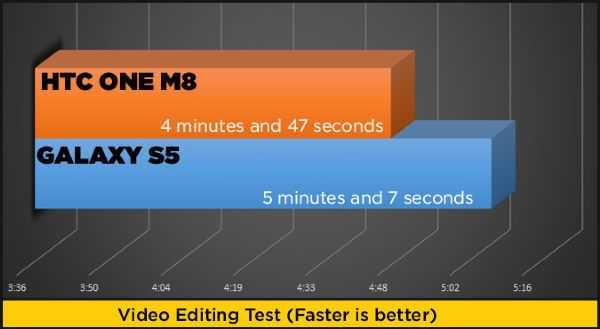
For our last real-world test, we pitted the S5 and One M8 against each other for a video editing test, transcoding a 204MB 1080p video file to 480p using the VidTrim app. The One M8 once again finished faster, taking 4 minutes and 47 seconds to the S5's 5:07.
The Galaxy S5 and HTC One M8 both turned in strong results on various benchmarks. The Samsung beat the One M8 on Geekbench 3, which measures multicore processor performance, with a score of 2,927 to 2,480.
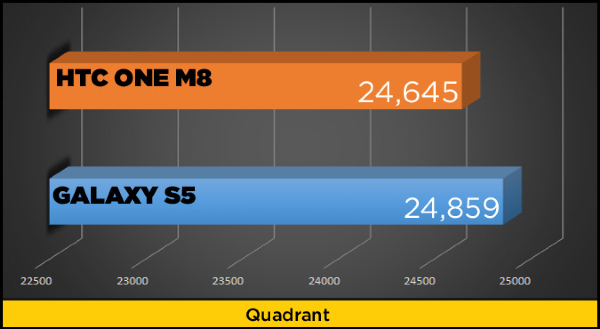
The S5 also edged out the One M8 on Quadrant (CPU, I/O and 3D graphics) to the tune of 24,859 to 24,645.
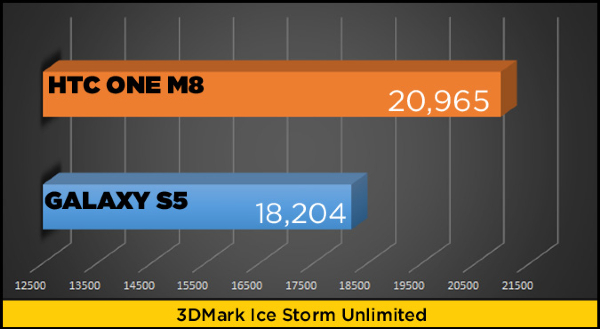
But the One M8 rebounded on the 3DMark Ice Storm Unlimited graphics test. The HTC hit 20,965 while the S5 registered 18,204.
Winner: HTC One M8. Don't be fooled by the synthetic benchmarks. The HTC One M8 is faster in everyday use.
Camera Features
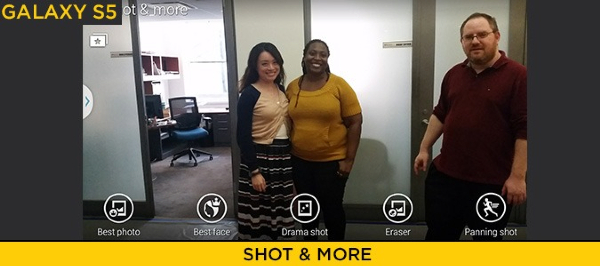
Samsung's Galaxy S5 gets an improved 16-megapixel camera and cleaner interface versus the S4 (13-MP). For example, the S5 now combines multiple camera modes into one via its Shot & More setting. From here you can shoot a photo, then adjust the image using the Best photo, Best face, Drama shot, Eraser and Panning shot modes.
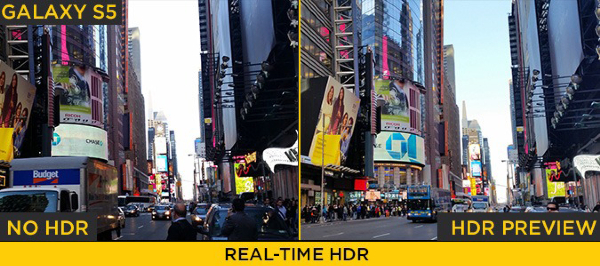
The S5's real-time HDR mode lets you see what your high-dynamic range photos will look like before taking them. HDR on the One M8 doesn't let you preview the results, and each shot takes longer to process.
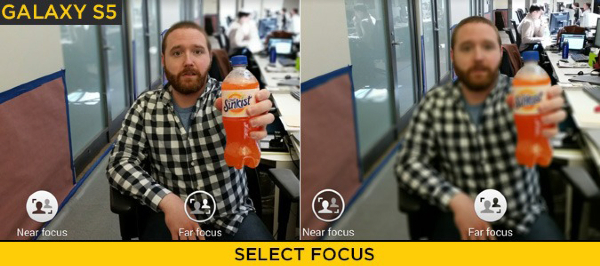
The S5 also gets a Select Focus mode, which lets you choose whether you want your photos to focus on the foreground or the background after you take them. The One M8's UFocus feature lets you can capture a photo, then adjust its focal point. But whereas the S5 only lets you focus on the background or foreground, the One M8 lets you focus on any part of the photo by tapping a specific area.

The HTC One M8's Duo camera combines the One M7's Ultrapixel camera with a new secondary shooter that captures image depth. Together, the cameras let you take 3D-like images that react to how you move the M8 similar to the iPhone's Parallax setting using the Dimension Plus option.
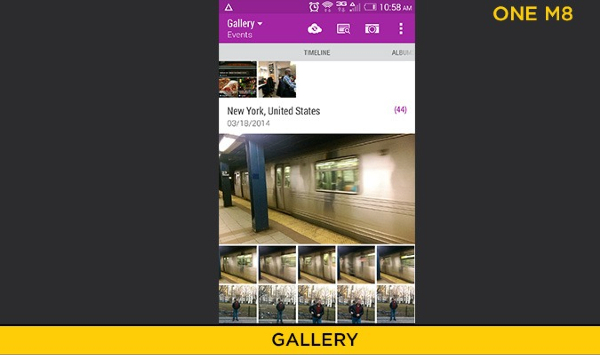
The One M8's Zoe feature now lets you capture longer videos depending on how long you hold down the record button. Zoe also get more functionality this time around, complete with a GIF creator, Sequence Shot and Object Removal. HTC has also improved the One M8's Gallery app, giving it a slide show setting complete with audio and transitions. The gallery will also organize your pictures based on when they were taken, where you shot them and if you took multiple images at the same time.
Overall, we prefer the S5's camera interface, because it's easier to change modes and tweak settings. For example, even switching to video mode requires two taps.
Winner: Samsung Galaxy S5. With the exception of the One M8's finer control over selective focus, the S5's camera features are more robust and intuitive.
Image Quality
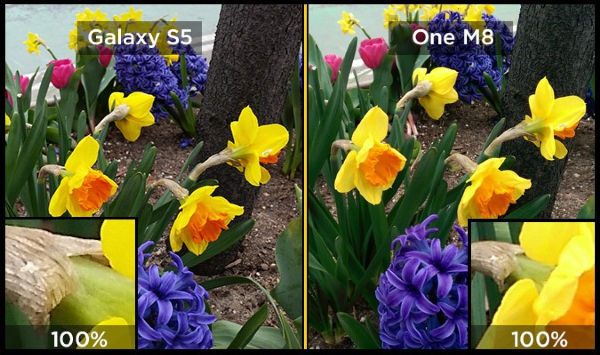
The Galaxy S5 and the One M8 both pack very capable cameras, but which is best? A photo of a flower pot taken outside with the S5 offered greater color contrast and far more detail. Thanks to its 16-megapixel sensor, we were able to zoom in far more on the S5's images than the One M8, which sports a relatively small 4-MP Ultrapixel sensor.
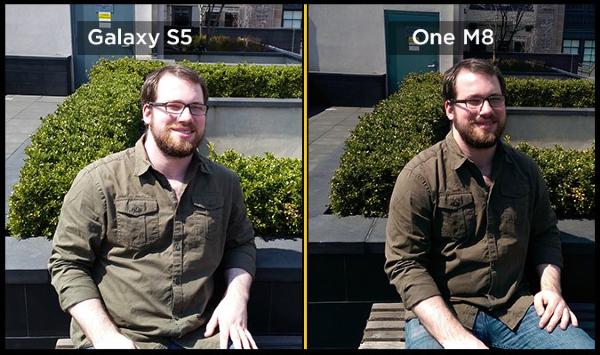
A shot taken of a man sitting in front of a row of green hedges looked different on both phones. The S5's image was too hot, causing our subject's skin to appear blown out, while the HTC One's photo was too dark. The background in the One M8’s image looked as clear as the foreground, while the S5's photo had a sharper foreground.

When we took a photo of an American flag on the side of a building in midafternoon, the difference between the One M8 and S5's cameras became abundantly clear. Whereas the S5 captured a clear image with gorgeous blues and reds, the One got overwhelmed by the midday sun, causing a heavy haze to appear across the image.
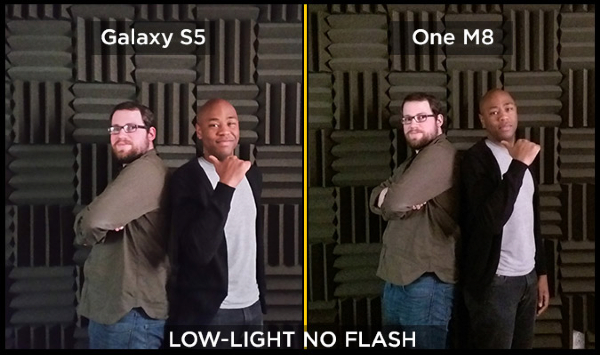
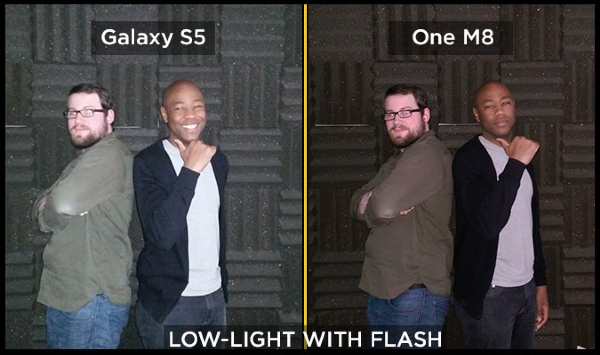
Low-light photos with both phones left much to be desired. The Galaxy S5's camera captured images that looked as though they had a magenta filter over them, while the One's camera made grays in the shot look greenish. Switch on the flash and you'll see similar results with both phones.
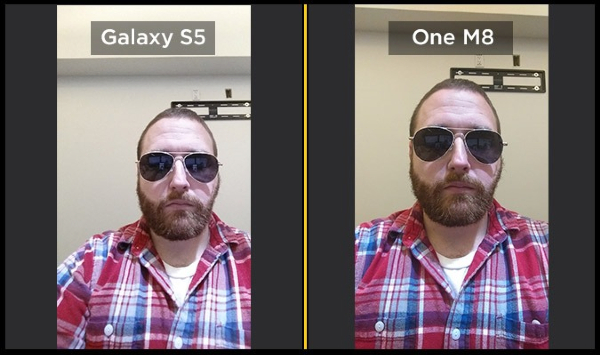
When it comes to shooting selfies, the HTC One M8's 5-megapixel shooter has the S5's 2.1-MP camera beat. Photos taken with the One looked cleaner and offered more detail than those taken with the S5. Colors were also more accurate and tended to bleed less in the HTC's images.
Winner: Samsung Galaxy S5. Though the HTC One M8 is better for selfies, the Galaxy S5 rear camera captured sharper and more colorful images. Plus, you can zoom in more on your photos for cropping.
Battery Life
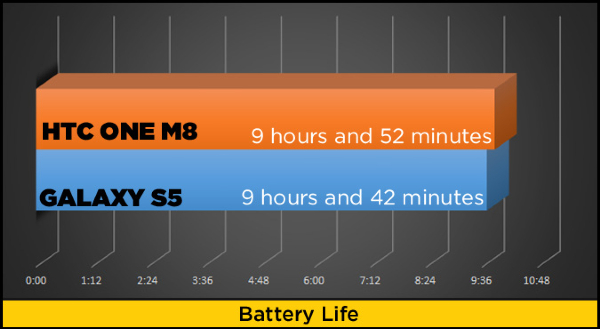
Samsung's Galaxy S5 houses a 2,800 mAh battery, which helped the phone last an impressive 9 hours and 42 minutes on the Laptop Mag Battery test. This involves continuous Web surfing over AT&T's 4G LTE network with the display brightness set to 150 nits. However, the HTC One M8's 2,600 mAH battery lasted 10 minutes longer in our test (over Verizon's network) for a runtime of 9:52.
If you want to squeeze every last drop out of the S5's battery, you can enable the phone's Ultra Power Savings Mode. When enabled, this mode switches the screen to grayscale, turns off mobile data when the phone's screen is off, disables Wi-Fi and Bluetooth and restricts application usage. HTC says it will add an enhanced power-saver mode to the One M8 via a future update, though timing has not been provided.
Winner: Draw. HTC's One M8 narrowly beat the Galaxy S5 on our battery test, but 10 minutes isn't much time when we're talking about 9-plus hours of endurance for both phones. Samsung's Ultra Power Saver Mode is available now, but we're still waiting on HTC's version.
Special Features
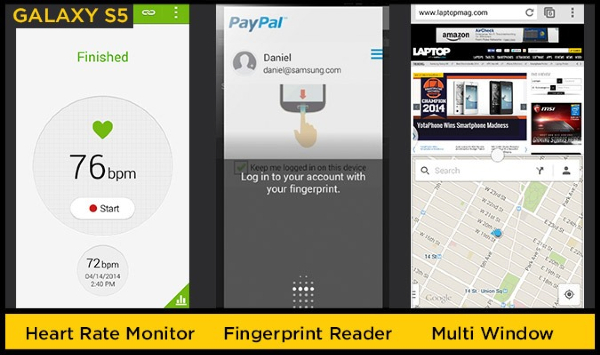
Samsung's Galaxy S5 packs a host of special features, including a built-in heart rate monitor, fingerprint reader and a water-resistant chassis.
The heart rate monitor, which uses a sensor next to S5's camera flash, can read your heartbeats per minute and transfer the information to the handset's S Health app. The app then combines your heart rate data with your daily caloric intake and steps taken to give you an overview of your health, although we didn't always get a reading the first time.
The S5's fingerprint reader, like Apple's Touch ID, lets you unlock your phone without having to enter a password. However, you can also make PayPal payments via the fingerprint reader, whether you're shopping online or in select physical stores. However, like the heart rate monitor, the fingerprint sensor wasn't consistent.
The S5's most compelling special feature is its water-resistant chassis. With its USB port cover closed, the S5 can survive in up to 1 meter of water for 30 minutes. You can't use the phone while it’s submerged, but it will withstand a quick dip.
It's also worth noting that only the Galaxy S5 (like the older S4) lets you run two apps on the screen at once via its Multi Window feature.

The HTC One M8's standout feature is its BoomSound speakers. They pump out the best-sounding audio of any smartphone.
The One M8's Motion Launch feature lets you unlock your photo by double-tapping the display. You can also swipe in from the left to unlock to BlinkFeed, swipe in from the right to unlock to the home screen, or swipe up from the bottom to unlock to your most recently used app.
HTC's BlinkFeed serves as an enhanced news reader that provides the latest stories from your favorite websites and social media apps. HTC will be also be adding Fitbit functionality to BlinkFeed, so you can quickly view your activity level. With Foursquare integration, BlinkFeed now provides nearby restaurant options. And with HTC's BlinkFeed SDK, users can expect to see additional app integration in the near future.
We're also rather big fans of HTC's slick Dot View case. Sporting a series of holes in its front cover, the case provides you with dot matrix-style notifications for everything from emails to text messages, not to mention and weather updates. What's more, you can answer calls with the case closed by picking up the One and placing it to your ear.
Winner: Samsung Galaxy S5. Although the fingerprint reader and heart rate monitor could be more reliable, the S5's water-resistance gives it the edge in this round.
Verdict
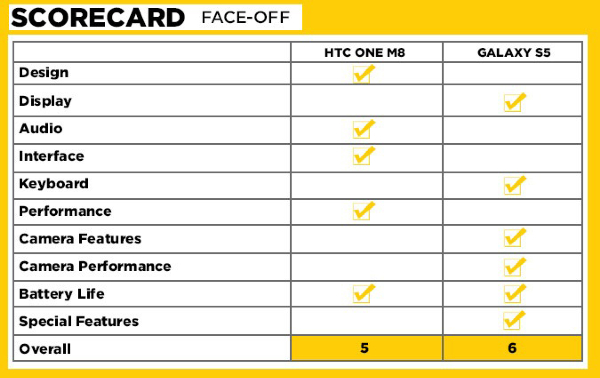
It’s very rare that we bestow a 4.5-star rating on any device, so the fact that the Galaxy S5 and HTC One M8 both earned that honor tells you how great both Android phones are. Nevertheless, the Galaxy S5 takes this very close contest 6 points to 5 in 10 rounds of combat.
The HTC One M8 has a sleeker design, much better audio and a more streamlined and user-friendly interface. The Duo Camera feature is clever, too, if a bit gimmicky. And if you care about speed and responsiveness, the One M8 is the smartphone to get.
However, the Galaxy S5 boasts a brighter and richer display and markedly better camera performance. We also appreciate the S5's more accurate keyboard (with dedicated number row), removable battery and water-resistant design. We consider the heart rate monitor and fingerprint sensor to be nice-to-have bonuses, since it will likely take an update for these features to work more reliably.
Overall, you would be very happy with either the HTC One M8 or the Galaxy S5, but the S5 wins this face-off.
Follow Mark Spoonauer at @mspoonauer. Follow Tom's Guide at @tomsguide, on Facebook and on Google+.
Mark Spoonauer is the global editor in chief of Tom's Guide and has covered technology for over 20 years. In addition to overseeing the direction of Tom's Guide, Mark specializes in covering all things mobile, having reviewed dozens of smartphones and other gadgets. He has spoken at key industry events and appears regularly on TV to discuss the latest trends, including Cheddar, Fox Business and other outlets. Mark was previously editor in chief of Laptop Mag, and his work has appeared in Wired, Popular Science and Inc. Follow him on Twitter at @mspoonauer.

